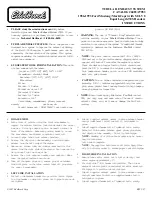
DRIVER SUPPORT
314
City Safety when evasive action is
not possible
City Safety can help the driver by automatically
braking the vehicle sooner if it is not possible to
steer out of a potential collision situation.
City Safety assists the driver by continuously try-
ing to determine possible "escape routes" to the
sides if a slow-moving or stationary vehicle ahead
is detected at a late stage.
Your vehicle (1) cannot "see" any way of veering to
avoid the vehicle ahead (2) and will attempt to auto-
brake sooner
Your vehicle
Slow moving/stationary vehicle
City Safety will not trigger the auto-brake func-
tion as long as the driver has a chance to avoid a
collision by steering the vehicle.
However, if City Safety determines that an eva-
sive steering maneuver is not possible due to a
lack of space in the adjacent traffic lanes, the
function will attempt to assist the driver by auto-
matically applying the brakes considerably
sooner.
WARNING
City Safety's capacity to assess certain traffic
situations is a supplemental aid to the driver
and does not function in all driving/traffic sit-
uations or weather/road conditions. It can
never replace the driver’s attention to traffic
conditions or his/her responsibility for operat-
ing the vehicle in a safe manner.
This function uses the vehicle's camera and
radar sensor, which have certain general limi-
tations. See the articles "Camera limitations"
and "Radar sensor limitations" for additional
information.
Related information
•
City Safety limitations (p. 314)
•
City Safety limitations
City Safety
™
may have limited or reduced func-
tionality in certain situations.
The function has several limitations that the driver
should be familiar with:
Low objects
Hanging objects, such as flags for overhanging
loads or accessories such as auxiliary lights or
front protective grids that extend beyond the
height of the hood may limit City Safety's func-
tion.
Slippery driving conditions
The extended braking distance on slippery roads
may reduce City Safety's capacity to help avoid a
collision. In situations of this type, the ABS
brakes and Electronic Stability Control will help
provide braking power and stability.
Backlighting
Strong sunlight, reflections, extreme light con-
trasts, the use of sunglasses, or if the driver is not
looking straight ahead may make the visual warn-
ing signal in the windshield difficult to see.
Heat
If the temperature in the passenger compartment
is very high due to e.g., strong sunlight, the visual
warning signal may be temporarily disabled.
Summary of Contents for S 90 2017
Page 1: ...OWNER S MANUAL ...
Page 2: ......
Page 14: ......
Page 15: ...INTRODUCTION ...
Page 58: ......
Page 59: ...SAFETY ...
Page 96: ......
Page 97: ...INSTRUMENTS AND CONTROLS ...
Page 182: ......
Page 183: ...CLIMATE ...
Page 208: ......
Page 209: ...LOADING AND STORAGE ...
Page 225: ...LOADING AND STORAGE 223 Load anchoring eyelets p 216 Loading p 214 ...
Page 226: ......
Page 227: ...LOCKS AND ALARM ...
Page 253: ...DRIVER SUPPORT ...
Page 365: ...STARTING AND DRIVING ...
Page 412: ......
Page 413: ...INFOTAINMENT ...
Page 462: ......
Page 463: ...WHEELS AND TIRES ...
Page 492: ......
Page 493: ...MAINTENANCE AND SERVICING ...
Page 529: ...MAINTENANCE AND SERVICING 527 ...
Page 543: ...SPECIFICATIONS ...
Page 558: ......
Page 569: ......
Page 570: ...TP 23148 English USA Canada AT 1717 MY18 Copyright 2000 2017 Volvo Car Corporation ...
















































